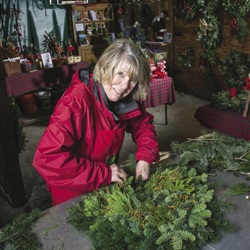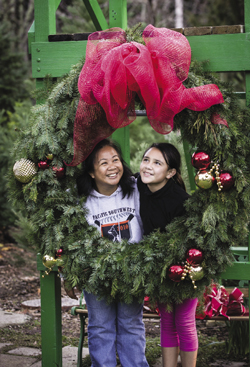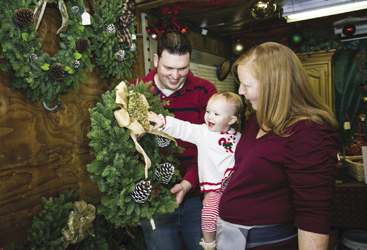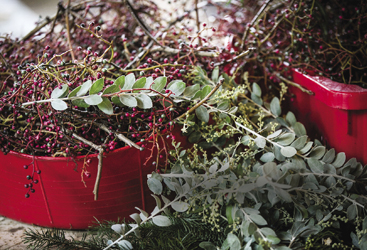Nov./Dec. 2013 California Bountiful magazine
Story by Ching Lee
Photos by Richard Green
A fresh welcome to the season.
December 23, 2018 - Right up there with the Christmas tree, the wreath is one of the most enduring symbols of the holiday season. But its endurance has a more literal meaning today, as local Christmas tree farms increasingly specialize in making the festive garlands fresh so they hold up through the year-end celebration.
(Left) Jim Beck, owner and founder of Patchen California Christmas Tree Farm in Santa Clara County, helps wreath-maker Marina Johnson with materials from his farm used to create the iconic holiday decoration.
"That's the fastest-growing part of our business," said Jim Beck, owner and founder of Patchen California Christmas Tree Farm in Santa Clara County. "I can see the time coming in the very near future when we will sell more wreaths than we sell Christmas trees."
Handmade wreaths have become such an integral part of Beck's choose-and-cut Christmas tree business that this year he is tripling the size of his production area and devoting an entire new building to making wreaths. Beck said while Christmas trees face competition from artificial trees, he's happy to see demand increasing for his farm's wreaths—made in large part using trees and other plant materials grown and found on the farm, including holly, mistletoe, pine cones and herbs.
(Right) Marina Johnson makes up to 15 wreaths a day during peak season.
"Even people who have plastic trees at home still would like to have that forest aroma in their living room, so we focus very heavily on handmade wreaths right here on the spot," Beck said. "We have people who have come back for many years—decades, in fact—who have a plastic tree at home, but they come here to buy a wreath."
Combining art with agriculture
The fun begins about a week before Thanksgiving, when Marina Johnson, who has been designing and making the farm's wreaths for nearly 10 years, releases her creativity on the round wire frames from which the wreaths are constructed.
Completely self-taught, Johnson said she learned how to make the iconic decoration by researching different techniques and designs on the Internet and in books. She gets many of her ideas from pictures of other wreaths, but adds her own touches so that she can  incorporate crops from the farm into her creations.
incorporate crops from the farm into her creations.
(Left) Dorothy Davidson and daughter Kelsey of Sacramento pose behind one of the farm's wreaths.
"We are pretty much the only place up here that has this kind of operation going," Johnson said of the farm, located in Los Gatos in the foothills of the Santa Cruz Mountains. "When I first came up here, we sold maybe 20 wreaths the first year. Now we're selling over 500."
A former executive in the technology industry, Beck started his Christmas tree business in 1969 when he bought the first piece of land that is now part of his 15-acre ranch. The land was once a town called Patchen, a name Beck decided to preserve for his farm. The old town existed for about a hundred years and flourished during the last half of the 19th century, featuring a post office, hotel and stagecoach stop in its heyday.
After acquiring the property, Beck said he thought about using the land for winegrapes or kiwifruit—both good choices at the time—but settled on Christmas trees instead.
"That sounded like a better idea," he said. "I think we were mostly motivated by the spirit around Christmas, knowing that folks are almost always in a joyful mood at that time of year, and it just sounded like a fun thing to do."
 (Right) Anthony and Katie Yvanovich of San Jose, with daughter Ellie, look at some of the wreaths on display.
(Right) Anthony and Katie Yvanovich of San Jose, with daughter Ellie, look at some of the wreaths on display.
The art of wreath-making
With the growth of the wreath business, the farm employs several workers during the holiday season specifically devoted to helping Johnson make and sell the wreaths. A modest-sized wreath takes about half an hour to make, and Johnson makes up to 15 a day.
Not all Christmas trees make good wreaths, however, as the foliage on some varieties dries out too quickly, Beck said.
For holiday wreaths, Johnson generally starts with Douglas fir, redwood or both, and then adds holly, mistletoe, pine cones, often sprigs of cedar and Arizona cypress, and sometimes lavender. She also makes herb wreaths using dried lavender, rosemary, thyme, bay leaves and oregano flowers grown on the farm. She makes fresh versions of the herb wreaths, too, which have become very popular because they dry as they hang and will last long after the holidays, she  said.
said.
 (Left) Jim Beck cuts holly for the farm's popular wreaths.
(Left) Jim Beck cuts holly for the farm's popular wreaths.
Sam Minturn, executive director of the California Christmas Tree Association, said not all of the state's choose-and-cut farms create or sell wreaths, but the ones that are successful at it, like Patchen, have made it their niche. He credits Johnson for much of Patchen's success with wreaths, noting that in recent years, she has won all of the association's wreath contests that she has entered.
Keeping it real
Beck said young families in particular tend to want a real tree because they like the experience of going to a farm, choosing the tree with their children and cutting it down.
"But as they get older and the kids go off to college, they don't want to mess around with a real tree anymore, but they still keep coming back for the wreaths," he said. "They also enjoy coming here for a visit. Just being able to watch the people make the wreaths and talk to them about all the different options is a big part of the attraction. That's really what drives our wreath business."

 (Right) Wreaths made from farm-fresh materials are known for their fragrance and longevity.
(Right) Wreaths made from farm-fresh materials are known for their fragrance and longevity.
Anthony and Katie Yvanovich of San Jose have been coming to Patchen for the last few years. Last year, the couple brought along their daughter Ellie, treating the tree-shopping experience as an outing, taking plenty of photos and enjoying the farm's free hot cider.
"We always get a Christmas wreath," Anthony Yvanovich said. "They do such beautiful wreaths. It's handmade. It smells super good and fresh. There's usually a person right there making them. I don't know where else I can get such a nice wreath. We usually come home with a carful of stuff."
Johnson said she's seeing more young people buy her fresh wreaths because they say they don't have room to store big ornaments, or they live in a space too small for a real tree, but they still want to hang a beautiful wreath and enjoy that scent. They are also more willing to splurge on perishable items, especially for special occasions, she said.
"Why not buy something that can last for a month?" she asked, noting that her wreaths usually last five to six weeks.
Ching Lee
clee@californiabountiful.com
How to keep wreaths evergreen
Fresh wreaths are green and fragrant straight from the farm, but proper care is needed to keep them looking and smelling their best through the holidays. Here are some tips from Marina Johnson:
- Don't hang the wreath directly in sunlight, as that will dry it out quickly.
- If the wreath is hung outdoors, especially if it's subjected to sun, dip the entire back of the wreath in a tub of shallow water for about an hour every few days.
- If the wreath is displayed indoors, spray the foliage with water, but avoid getting the other decorative materials wet, such as the lavender and pine cones.
Reprinted with permission: California Farm Bureau Federation








